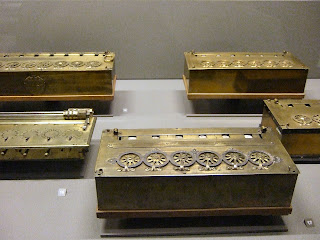Pont Neuf, which means “New Bridge“ in French, is the oldest bridge in Paris. It is also one of the best-known. The Pont Neuf consists of two different bridge spans, one on each side of the Ile de la Cite, where the Place du Pont Neuf connects the two spans. The bridge has a total of 12 arches, with one span of seven arches joining the right bank and another span of five arches connecting Île de la Cité with the left bank.
Pont Neuf and Place du Pont Neuf with equestrian statue of Henry IV
Arches of Pont Neuf toward the left bank
Notice the niches along the bridge. These niches (called “bastions“) were created for the safety of pedestrians seeking to avoid being run over by passing carriages hurrying by or splashed by mud or horses going by on the bridge.
In 1607, the bridge was officially opened by King Henry IV. Henry was one of the most popular French kings, both during and after his reign. He showed great care for the welfare of his subjects and, as a ruler, displayed an unusual religious tolerance for the time. He enacted the Edict of Nantes in 1598, which guaranteed religious liberties to Protestants. He was assassinated in 1610 by a fanatical Catholic. After his death, an equestrian statue of the King was erected at the center of the bridge, on the Place du Pont Neuf.
Pont Neuf commemorative marker
King Henry IV
King Henry IV
King Henry IV
King Henry IV
Henry IV was known as the “Vert Galant” (literally, green gentleman) because he was forever youthful in his passionate pursuit of the ladies. His womanizing was legendary, and he fathered many children with a number of mistresses. From his vantage point, the equestrian statue of the Vert Galant keeps watch over a picturesque little park on the tip of the Ile de la Cite, the Square du Vert-Galant. Romance is still in the air because today the garden is a popular spot for marriage proposals. The park is also where the Vedettes du Pont Neuf tour boats on the Seine depart from.
Square du Vert-Galant, on the tip of the Ile de la Cite
Circular bench in the park nearby the place where the Vedettes tour boats dock
A corner of the park
Gated entrance to the Square du Vert-Galant
This is the park in October, when the garden beds have not yet been replanted for the fall.







































































